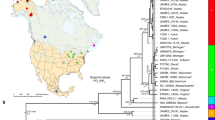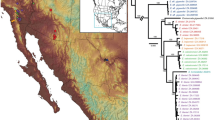Abstract
Ancient DNA studies have typically used multi-copy mitochondrial DNA sequences1,2. This is largely because single-locus nuclear genes have been difficult to recover from sub-fossil material3, restricting the scope of ancient DNA research. Here, we have isolated single-locus nuclear DNA markers to assign the sex of 115 extinct moa and, in combination with a mitochondrial DNA phylogeny, tested competing hypotheses about the specific status of moa taxa. Moa were large ratite birds that showed extreme size variation both within and among species4. For some taxa, this large variation was hypothesized to represent sexual dimorphism, while for others it was argued to reflect the existence of different species5. Our results show that moa were characterized by extreme reverse sexual dimorphism and as a result we have been able to clarify the number of moa species. For example, we show that the three recognized ‘species’ of Dinornis comprised only two monophyletic groups and that two of these ‘species’ comprised individuals of one sex only. This study also illustrates that single-locus nuclear DNA sequences can be consistently recovered from ancient material.
This is a preview of subscription content, access via your institution
Access options
Subscribe to this journal
Receive 51 print issues and online access
$199.00 per year
only $3.90 per issue
Buy this article
- Purchase on Springer Link
- Instant access to full article PDF
Prices may be subject to local taxes which are calculated during checkout



Similar content being viewed by others
References
Higuchi, R. et al. DNA sequences from the quagga, an extinct member of the horse family. Nature 312, 282–284 (1984)
Herrmann, B. & Hummel, S. (eds) Ancient DNA (Springer, New York, 1993)
Cooper, A. & Wayne, R. New uses for old DNA. Curr. Opin. Biotechnol. 9, 49–53 (1998)
Anderson, A. J. Prodigious Birds: Moas and Moa-Hunting in Prehistoric New Zealand (Cambridge Univ. Press, Cambridge, UK, 1989)
Cracraft, J. The species of moa. Smithson. Contrib. Paleobiol. 27, 189–205 (1976)
Pikô, L. & Taylor, K. D. Amounts of mitochondrial DNA and abundance of some mitochondrial gene transcripts in early mouse embryos. Dev. Biol. 123, 364–374 (1987)
Hofreiter, M., Serre, D., Poinar, H. N., Kuch, M. & Pääbo, S. Ancient DNA. Nature Rev. Genet. 2, 353–359 (2001)
Cooper, A. et al. Complete mitochondrial genome sequences of two extinct moas clarify ratite evolution. Nature 409, 704–707 (2001)
Haddrath, O. & Baker, A. J. Complete mitochondrial DNA genome sequences of extinct birds: ratite phylogenetics and the vicariance biogeography hypothesis. Proc. R. Soc. Lond. B 268, 939–945 (2001)
Leonard, J. A. et al. Ancient DNA evidence for Old World origin of New World dogs. Science 298, 1613–1616 (2002)
Asfaw, B. et al. Remains of Homo erectus from Bouri, Middle Awash, Ethiopia. Nature 416, 317–320 (2002)
Weins, J. & Penkrot, T. Delimiting species using DNA and morphological variation and discordant species limits in spiny lizards (Sceloporus). Syst. Biol. 51, 69–91 (2002)
Holdaway, R. N. & Jacomb, C. Rapid extinction of the moas (Aves: Dinornithiformes): model, test, and implications. Science 287, 2250–2254 (2000)
Polack, J. New Zealand, Being a Narrative of Travels and Adventures (Richard Bentley, London, 1838)
Owen, R. On the bone of an unknown struthious bird from New Zealand, meeting of November 12, 1839. Proc. Zool. Soc. Lond. VII, 169–171 (1839)
Worthy, T. H. & Holdaway, R. N. The Lost World of the Moa: Prehistoric Life of New Zealand (Canterbury Univ. Press, Christchurch, 2002)
Clinton, M. & Haines, L. C. An overview of factors influencing sex determination and gonadal development in birds. Cell. Mol. Life Sci. 55 876–886 (1999)
Ansari, H., Kakagi, N. & Sasaki, M. Morphological differentiation of sex chromosomes in three species of ratite birds. Cytogenet. Cell Genet. 47, 185–188 (1988)
Huynen, L., Millar, C. D. & Lambert, D. M. A DNA test to sex ratite birds. Mol. Ecol. 11, 851–856 (2002)
Griffiths, R., Double, M. C., Orr, K. & Dawson, R. J. A DNA test to sex most birds. Mol. Ecol. 7, 1071–1076 (1998)
Ellegren, H. First gene on the avian W chromosome (CHD) provides a tag for universal sexing of non-ratite birds. Proc. R. Soc. Lond. B 263, 1635–1641 (1996)
Taberlet, P. & Luikart, G. Non-invasive genetic sampling and individual identification. Biol. J. Linnean Soc. 68, 41–55 (1999)
Taberlet, P. et al. Reliable genotyping of samples with very low DNA quantities using PCR. Nucleic Acids Res. 24, 3189–3194 (1996)
Worthy, T. H. An illustrated key to the main leg bones of moas (Aves: Dinornithiformes). Nat. Mus. NZ Misc. Ser. 17, 1–27 (1988)
Cooper, A. in Avian Molecular Evolution and Molecular Systematics (ed. Mindell, D.) 345–373 (Academic Press, New York, 1997)
Prange, H. D., Anderson, J. F. & Rahn, H. Scaling of skeletal mass to body mass in birds and mammals. Am. Nat. 113, 103–122 (1979)
Lambert, D. M. et al. Rates of evolution in ancient DNA from Adélie penguins. Science 295, 2270–2273 (2002)
Sambrook, J., Fritsch, E. F. & Maniatis, T. Molecular Cloning: A Laboratory Manual (Cold Spring Harbor Laboratory Press, New York, 1989)
Griffiths, R. & Tiwari, B. Sex of the last wild Spix's macaw. Nature 375, 454 (1995)
Swofford, D. L. PAUP*: Phylogenetic Analysis Using Parsimony (*and Other Methods) Version 4.0b10 (Sinauer Associates, Sunderland, Massachusetts, 2002)
Acknowledgements
This research was made possible by grants from the Marsden Fund, Massey University and the Centres of Research Excellence Fund. We are grateful to the following institutions and people: Museum of New Zealand Te Papa Tongarewa, Canterbury Museum, Auckland Institute and Museum, Massey University, Otago Museum, Waitomo Caves Museum, Whanganui Regional Museum, Te Manawa Museum, Institute of Geological and Nuclear Sciences, J. Anderson, J. A. Bartle, A. Tennyson, T. Worthy and V. Ward. We appreciate the support of a number of iwi, especially Ngai Tahu and Ngati Kahungunu.
Author information
Authors and Affiliations
Corresponding author
Ethics declarations
Competing interests
The authors declare that they have no competing financial interests.
Rights and permissions
About this article
Cite this article
Huynen, L., Millar, C., Scofield, R. et al. Nuclear DNA sequences detect species limits in ancient moa. Nature 425, 175–178 (2003). https://doi.org/10.1038/nature01838
Received:
Accepted:
Issue Date:
DOI: https://doi.org/10.1038/nature01838
This article is cited by
-
Molecular exploration of fossil eggshell uncovers hidden lineage of giant extinct bird
Nature Communications (2023)
-
Ancient DNA microsatellite analyses of the extinct New Zealand giant moa (Dinornis robustus) identify relatives within a single fossil site
Heredity (2015)
-
Reconstruction and in vivo analysis of the extinct tbx5 gene from ancient wingless moa (Aves: Dinornithiformes)
BMC Evolutionary Biology (2014)
-
Ancient DNA studies: new perspectives on old samples
Genetics Selection Evolution (2012)
-
Reproductive investment in moa: a K-selected life-history strategy?
Evolutionary Ecology (2012)
Comments
By submitting a comment you agree to abide by our Terms and Community Guidelines. If you find something abusive or that does not comply with our terms or guidelines please flag it as inappropriate.



